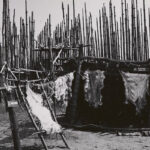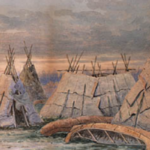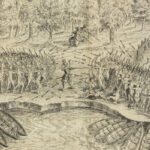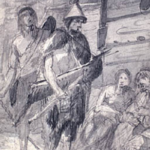The Eel Ground First Nation: A Legacy of Adaptation and Resilience
The Eel Ground First Nation, located along the banks of the Miramichi River in New Brunswick, represents a remarkable chapter in the history of the Mi’kmaq people. With roots that trace back thousands of years, the community has maintained its connection to the land and waters while adapting to profound changes brought by European contact and colonization. The story of Eel Ground is one of survival, cultural continuity, and resilience, offering a unique perspective on the enduring strength of the Mi’kmaq people.
Pre-History: The Mi’kmaq of the Miramichi River
The ancestors of the Eel Ground First Nation have lived in the Miramichi region for over 10,000 years, their presence marked by archaeological evidence of campsites, tools, and fishing weirs along the river. The Miramichi River was central to their way of life, serving as both a transportation corridor and a source of sustenance. The river’s abundant fish, particularly Atlantic salmon and eels, played a vital role in the community’s diet and economy, while the surrounding forests provided game, berries, and materials for tools and shelter.
The Mi’kmaq of Eel Ground followed a seasonal cycle of movement, wintering inland to hunt moose and caribou and spending summers near the river to fish and gather. This pattern reflected their deep understanding of the environment and their ability to sustainably manage its resources. Spiritual beliefs were closely tied to the natural world, emphasizing respect and reciprocity with the land and animals that sustained them.
Anthropologist Harold Hickerson, in The Algonquian Peoples of the Boreal Forest, noted, “For the Mi’kmaq, the river was not simply a geographical feature but a lifeline, an integral part of their identity and survival.”
Governance and Social Structure
The Mi’kmaq of Eel Ground were part of the broader Mi’kmaq Nation, which was organized into seven districts, each with its own leader or Sagamore. These districts were united under the Grand Council (Santé Mawiómi), which resolved disputes, managed resources, and maintained peace among the Mi’kmaq people.
At the community level, decisions were made collectively, with chiefs and elders serving as guides and mediators. This consensus-based governance reflected the Mi’kmaq emphasis on unity and mutual respect. Oral traditions, passed down through generations, played a vital role in preserving the community’s history, spiritual teachings, and cultural practices.
First Contact with Europeans
The arrival of European explorers in the 16th century brought profound changes to the Mi’kmaq of Eel Ground. Basque and Breton fishermen, drawn to the rich waters of the Gulf of St. Lawrence, were among the first Europeans to encounter the Mi’kmaq. These early interactions were largely transactional, with the Mi’kmaq trading furs for European goods such as metal tools, cloth, and beads.
The establishment of French settlements in the region during the 17th century deepened these relationships. French missionaries and traders, including those associated with Samuel de Champlain, sought alliances with the Mi’kmaq, recognizing their strategic importance as intermediaries in the fur trade and their knowledge of the land and waterways. The Mi’kmaq, including those at Eel Ground, became important allies of the French, offering guidance, labour, and military support.
The Fur Trade and French Alliances
The fur trade became a cornerstone of Mi’kmaq-European relations. The Mi’kmaq of Eel Ground played a critical role as trappers and intermediaries, supplying furs to French traders in exchange for goods that enhanced their daily lives. The introduction of European goods transformed aspects of Mi’kmaq life, from hunting practices to domestic tools, but it also introduced dependencies and disrupted traditional economies.
The Mi’kmaq also fought alongside the French during conflicts with the British, including the Seven Years’ War (1756–1763). These alliances, rooted in mutual benefit, were tested following the British victory, which brought new challenges to the Mi’kmaq way of life.
British Encroachment and Adaptation
The British conquest of New France in 1763 marked a turning point for the Mi’kmaq of Eel Ground. British policies often ignored Indigenous sovereignty, leading to encroachments on Mi’kmaq lands and resources. The Proclamation of 1763, which aimed to protect Indigenous territories, was largely undermined by settler expansion and resource exploitation.
Despite these pressures, the Mi’kmaq of Eel Ground adapted. They continued to rely on the Miramichi River for fishing, hunting, and transportation while engaging in new economic activities introduced by settlers, such as logging and farming. The river remained central to their identity, sustaining both their cultural practices and economic livelihoods.
Missionaries and Cultural Change
The arrival of missionaries, particularly Catholic priests, brought significant cultural changes to Eel Ground. Missionaries sought to convert the Mi’kmaq to Christianity, often clashing with traditional spiritual beliefs. Over time, many Mi’kmaq adopted aspects of Christianity, integrating it with their existing practices rather than abandoning their traditions entirely.
The influence of missionaries also extended to education and governance, introducing new systems that sometimes conflicted with traditional Mi’kmaq structures. Despite these changes, the Mi’kmaq of Eel Ground preserved much of their cultural heritage through oral traditions, ceremonies, and seasonal activities.
Cultural Resilience and Revitalization
Throughout their history, the Mi’kmaq of Eel Ground have demonstrated remarkable resilience in preserving their language, Mi’kmawi’simk, and cultural traditions. Seasonal activities, such as salmon fishing and eel trapping, remain central to community life, connecting members to their ancestral practices and the river that sustains them.
Efforts to revitalize the Mi’kmaq language and culture include educational programs, cultural workshops, and community events. The Eel Ground Powwow, an annual gathering, celebrates Mi’kmaq traditions through drumming, dancing, and storytelling, fostering a sense of pride and unity within the community.
Environmental Stewardship and Advocacy
The Mi’kmaq of Eel Ground have long been stewards of the Miramichi River and its surrounding ecosystems. Their traditional ecological knowledge, passed down through generations, informs their approach to resource management, ensuring that fishing, hunting, and forestry practices remain sustainable.
Modern challenges, such as overfishing, pollution, and climate change, have heightened the need for advocacy. The community has taken an active role in protecting the river and its resources, partnering with environmental organizations and governments to address these issues. Their efforts reflect a deep commitment to preserving the river for future generations.
Eel Ground Today: A Thriving Community
Today, the Eel Ground First Nation is a vibrant and dynamic community of approximately 900 members. Investments in education, healthcare, and infrastructure reflect their commitment to creating opportunities for future generations. Cultural tourism, including guided tours and participation in traditional activities, has become an important part of the local economy, showcasing the community’s rich heritage.
The Eel Ground First Nation continues to balance economic development with cultural preservation, ensuring that their traditions and identity remain strong in a rapidly changing world. The community’s resilience and adaptability are a testament to the enduring strength of the Mi’kmaq people.
Conclusion: A Legacy of Resilience and Continuity
The history of the Eel Ground First Nation is a testament to their resilience, adaptability, and deep connection to the land and waters of the Miramichi River. From their ancient presence along the river’s shores to their central role in early European trade and their modern efforts in cultural revitalization and environmental advocacy, the Mi’kmaq of Eel Ground have maintained their identity and place within Canada’s evolving landscape.
As an elder from Eel Ground once said, “The river is our lifeblood, our connection to the past and the future. By honouring our traditions and protecting the land, we ensure that our story continues for generations to come.”
References
- Brightman, Robert. Grateful Prey: Rock Cree Human-Animal Relationships. University of California Press, 1993.
- Whitehead, Ruth Holmes. The Old Man Told Us: Excerpts from Micmac History, 1500–1950. Nimbus Publishing, 1991.
- Jesuit Relations. Documents of the Missions to New France. McGill University Press, 1962.
- Conrad, Margaret. A Concise History of Canada. Cambridge University Press, 2012.
- Hickerson, Harold. The Algonquian Peoples of the Boreal Forest. McGill-Queen’s University Press, 1973.
- Environmental Justice Advocacy Group. Stewardship and Sovereignty: The Role of the Mi’kmaq in Environmental Advocacy. University of Guelph Press, 2019.
- Eel Ground Cultural Centre. Guardians of the Miramichi: The History and Culture of Eel Ground. Eel Ground Publications, 2015.
- Mi’kmaq Grand Council. Santé Mawiómi: Traditions and Governance of the Mi’kmaq Nation. Halifax Press, 1985.
- Johnston, Basil. Ojibway Heritage. McClelland & Stewart, 1976.
- Ridington, Robin. Trail to Heaven: Knowledge and Narrative in a Northern Native Community. Douglas & McIntyre, 1988.



